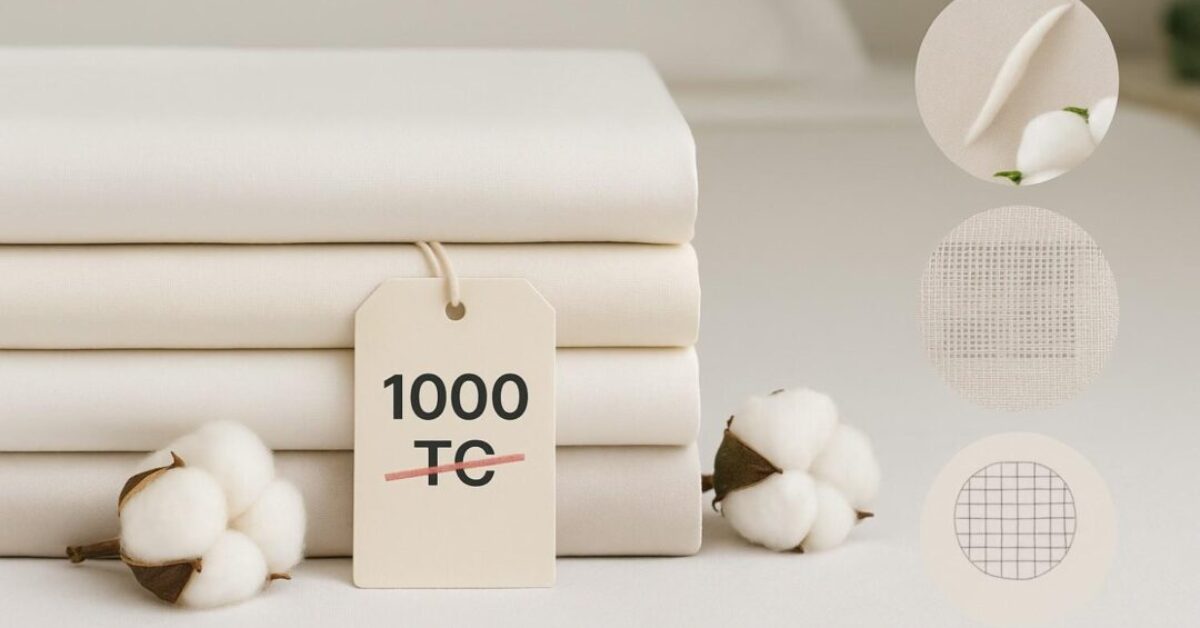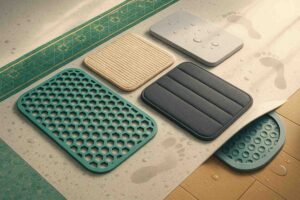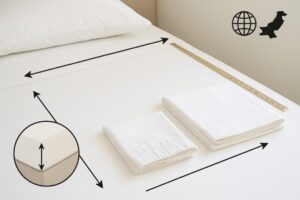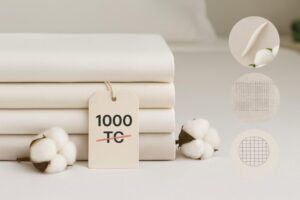You’re scrolling product pages and every brand is shouting a bigger number. 600, 800,1000. It’s like a scoreboard for sleep. The implication is obvious: higher thread counts equals better sheets. The truth is kinder (and cheaper): beyond a reasonable range, thread count stops being a reliable signal. What actually decides how your sheets feel, breathe, and age is a mix of fiber quality, weave, finishing, and weight plus whether those choices suit your climate and your sleep style.
This guide is global first with a Pakistan lens. So whether you’re outfitting a home in Karachi, a rental in Dubai, a flat in London, or a winter numbed bedroom in Toronto, you’ll finish with a clear plan and much less hype.
How thread count became a numbers game
Thread count (TC) simply counts the number of threads per square inch of fabric. If you weave more threads in, you can make the cloth denser. That’s it. Somewhere along the way, a simple measurement turned into a marketing arms race: if 300 is good, then 1000 must be incredible. Right?
Not exactly. Past a certain point, pushing more threads into the same space can require tricks that don’t improve quality sometimes they make it worse.
The two most common tricks:
- Multiply yarn inflation:
Instead of one strong, long fiber spun into a single yarn (singleply), weaker short fibers are twisted into multiply yarns. Brands then count each ply as a “thread,” inflating TC without improving the fabric. The sheet may feel heavy and dense at first but can pill or weaken quickly. - Finish masking:
Heavy chemical softeners and resins make a stiff, dense fabric feel nicer out of the bag. After a few washes, the “spa feel” fades and the true quality show up.
The lesson: a huge number is neither a guarantee nor a villain on its own it’s just not the thing that tells you whether the sheet will be a joy to live with.
What thread count actually measures and where it helps
TC can be a ballpark indicator when:
- You’re comparing similar fabrics (same fiber, same weave, same finishing).
- You’re staying in sensible ranges:
- Percale: ~200–400 feels breathable and crisp.
- Sateen: ~300–500 feels smooth and drapey.
In those ranges, TC can help you avoid extremes: a super low count might feel flimsy; a mega high count might be hot and stiff. But “300” from a trustworthy maker can beat “800” from a corner cutter every day of the week.
The five things that matter more than a giant TC number
1) Fiber quality (choose longstaple cotton)
Longer cotton fibers make stronger, smoother yarns with fewer ends poking out. That’s your defense against pilling and that “sandpapery” feel. Names you’ll see: Egyptian, Pima/Supima, and high-grade long staple cotton. Honest brands will say long staple or extra long staple; great ones will talk about ginning, combing, and spinning consistency too.
2) Weave (percale vs sateen and why it changes the feel)
- Percale (oneover, oneunder): crisp, matte, airy. Wonderful for heat and humidity.
- Sateen (three or four floats over, one under): smoother, drapier, slightly warmer to the touch.
Weave determines hand feel, drape, and airflow, often more than TC does.
3) Finishing (the cleanup that decides softness and stability)
Great finishing removes residuals, sets the fabric (preshrinks), and stabilizes color. It’s the difference between “soft out of the bag, then disappointing” and “soft, then lovelier after three washes.”
4) Weight (GSM) and yarn size (denier/Ne)
You won’t always see GSM listed for sheets, but weight influences warmth and drape. Too heavy and sateen can feel swampy in summer. Too light and percale can feel papery. Good makers balance yarn fineness with GSM so the fabric breathes, drapes, and lasts.
5) Honesty (spec clarity beats buzzwords) A trustworthy product page tells you: fiber type, weave, approximate TC, finishing claims (preshrunk, mercerized), and care. If a page shouts “1000TC” and nothing else, you’ve learned very little.
Match your sheets to your climate
- Hot & humid (Karachi summer, Dubai in August, Singapore year-round):
Go percale in the 300ish range, long staple cotton. Airflow and quick dry matter. Keep the rest of the bed light (breathable duvet, lighter blanket). - Temperate or cool with AC or long winters (London flats, Lahore winters, Toronto):
Go sateen around 350–450. You get a gentle cocoon without feeling sticky. Pair with a midweight duvet; avoid the heaviest sateens that trap heat. - Mixed climates/guest rooms/you share a bed with opposite preferences:
Keep one percale set and one sateen set and swap with the season (or mood). It’s the most cost-effective “upgrade” you’ll feel immediately.
Realistic sweet spots so you stop second-guessing
- Percale: 200–400 TC (with long staple cotton) = cool, crisp, durable.
- Sateen: 300–500 TC (with long staple cotton) = smooth, drapey, polished.
Could you love a 180 TC percale? Yes, if the yarn is great and you like ultralight. Could a 600 TC sateen be wonderful? Yes, if it’s honestly made and not overtight. But you’ll hit the bullseye more often inside the bands above.
Feel tests you can try in a store or with a sample
- The scrunch test: Scrunch a corner. Percale springs back with a faint rustle; sateen slumps and glides.
- The breathing test: Hold a layer over your mouth and blow gently. If air moves easily, you’re in breathable territory.
- The light test: Lift to a window. Percale shows a tiny grid; sateen looks smoother with a soft glow.
The patience test: Rub the same spot lightly for 20–30 seconds. Cheap finishing feels “waxy” then suddenly grabs; clean finishing stays consistently smooth.
Fiber types, quickly without the rabbit hole
- Egyptian cotton: A reputation for excellence but only when it’s genuine and longs-taple.
- Pima / Supima: American-grown long staple cotton; superb when spun well.
- Bamboo/viscose from bamboo: Soft with nice drape; good for sensitive skin. Can feel warmer in still air; quality varies wildly.
- Microfiber: Very soft and affordable but tends to trap heat and oils; not ideal if you sleep hot.
- Linen (flax): Not cotton, but worth a nod. Airy, strong, crinkles beautifully. Best in dry heat; feels coolest after a few washes.
If your priority is year-round versatility across climates, long staple cotton remains the most forgiving choice.
Durability: the unglamorous secret laundry
Whatever you buy, the wash routine decides longevity:
- Temperature: Cool to warm wash is enough. Hot water shortens life over time, especially for sateen.
- Detergent: Mild. Avoid fabric softeners (they coat fibers and reduce breathability). If you want extra softness, add a small splash of white vinegar in the rinse to clear residues.
- Drying: Medium heat. Pull while slightly warm and smooth by hand. Overdrying bakes in wrinkles and stresses fibers.
- Sorting: Keep zippers, hooks, and rough items away from sheets to prevent snags specially with sateen.
Hotels and rentals often love percale for its tolerance to frequent, hotter cycles. Sateen shines in premium rooms and photo ops. Many hospitality programs specify both, rotating by season or room category.
Buying traps to dodge
- “1200TC luxury!!” with no fiber/weave info. Pass.
- Mystery blends with vague “cotton-rich” claims. Ask for the exact composition.
- Too good to be true pricing on “Egyptian” with no certification or mill traceability.
Instant but temporary softness: Heavy softening chemistry can fake hand feel. Check reviews after three months, not just unboxing day.
How to read a product page like a pro your mini spec sheet
Look for these five lines, and you’ll make better decisions in minutes:
- Fiber: “100% long staple cotton” (or Supima/Pima/Egyptian with credible sourcing).
- Weave: “Percale” or “Sateen” (not just “luxury cotton”).
- Thread Count: A sane range (percale 200–400, sateen 300–500).
- Finishing: Preshrunk, colorfast, OEKOTEX/harmless chemistry; ideally mercerized (for color stability) and wellcalendered (for surface).
- Care: Clear, simple instructions (no guesswork).
If the page tells you these five, the brand probably respects your sleep more than their ad copy.
Global sizes
Bed sizes roam the map. A US King isn’t a UK King, and neither matches a standard PK King. The silent killer of great sheets is mattress depth (especially with toppers). When a fitted sheet pops off at 3 a.m., nobody sleeps well.
- Measure your mattress depth with topper for fitted sheets.
- If you’re in Pakistan buying for export or guests abroad, check the region’s size chart.
If in doubt, a generous flat sheet + tidy hospital corners beats a too shallow fitted sheet every time.
Sustainability without the lecture
- Buy fewer, better. One honest percale and one honest sateen set can outlast a stack of “bargains.”
- Wash cooler, dry lighter. Big impact, zero sacrifice.
- Skip heavy softeners. Better for skin, fabric, and water systems.
Rotate sets. Two to three per bed spreads the load your textiles and wallet last longer.
TLDR but the helpful kind
- Thread count is a tool, not a trophy. Use it within ranges and only when the rest of the spec is honest.
- Feel first:
- Run hot or live in humidity? Percale.
- Love a cosy wrap or cooler climates? Sateen.
- Quality markers: long staple cotton, clear weave, clean finishing, sensible weight.
Care wins: mild detergent, medium heat, no heavy softeners.
Where Ranyal lands and why
We’re Pakistan based with a global audience, and we build both percale and sateen with long staple cotton because homes and climates aren’t one note. Our percale aims for that quiet, cool crispness that softens beautifully after a few washes. Our sateen is tuned to drape without smothering, so Ac cool bedrooms feel warm enough without getting clammy.
We publish specs clearly so you can choose by feel and climate, not by who shouts the biggest number. If you’re still unsure, start simple: one percale set (~300 TC), one sateen set (~400 TC). Sleep on each for a fortnight, swap, then reorder your favorite. That beats guessing at 1000 TC from a mystery mill every time.




